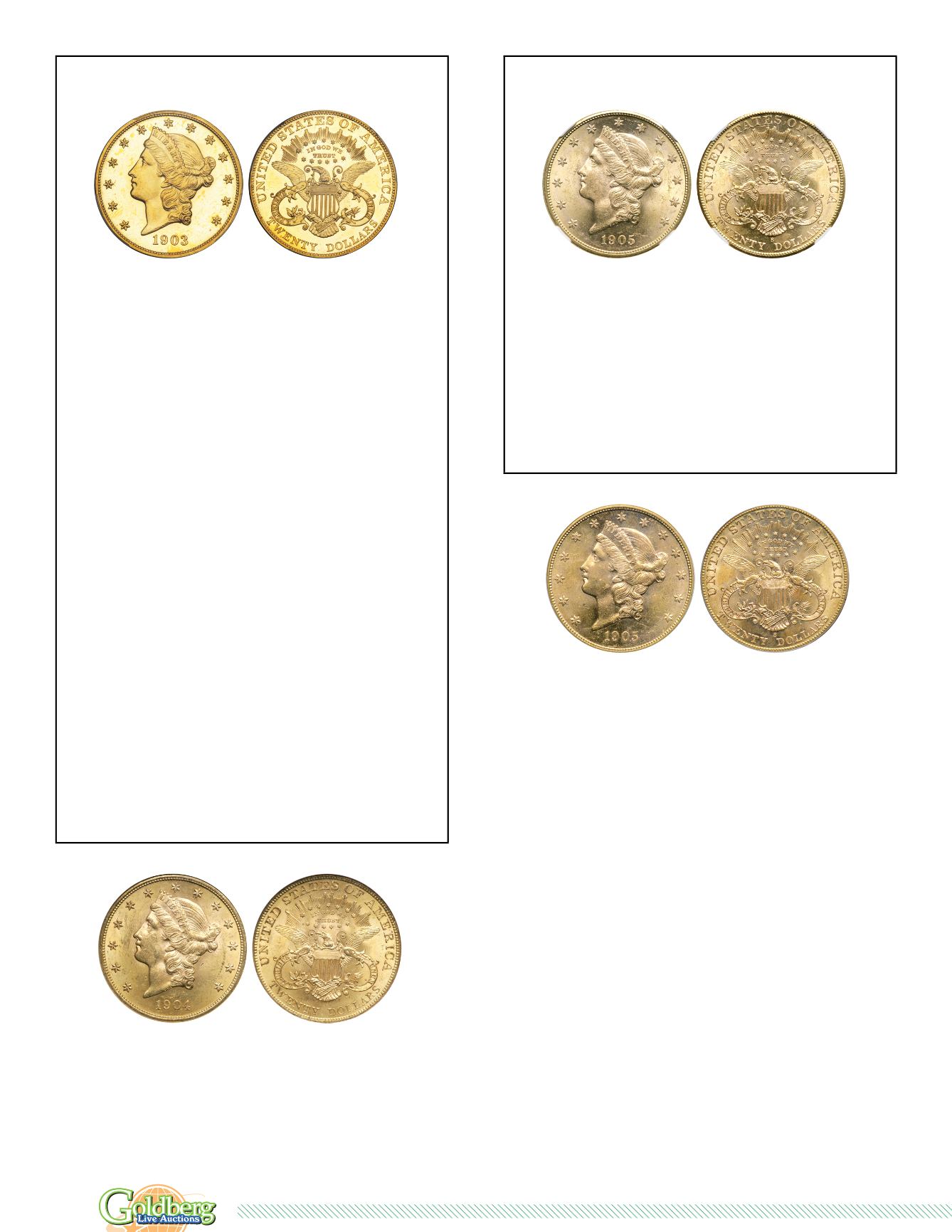
306
|
$20 Gold
P
OPULAR
P
ROOF
1903 $20 L
IBERTY
1986
1903
.
PCGS graded Proof 64
. Lovely rich golden toning.
Only 158 minted. True to form, this lovely Proof 1903 Dou-
ble Eagle exhibits stunning golden orange colors displayed
on both sides. Hardly any hairlines. All 1903 Proofs are the
same, stylistically. This particular date has the obverse field
deeply basined, from the die-making process, adding more
curvature than normal, and giving an especially interesting
satiny accent to the devices. Likely an early strike since the
mint often had to remove Proof dies from the press to
given them renewed polish, some 1903 Proof issues will
show a little break at the bridge of Liberty's nose from the
method used to polish the die. This one has a full nose
bridge, which indicates it must have come early in the pro-
duction run. Every collector who contemplates buying a
classic Proof Liberty $20 gold piece will want to check this
1903 $20 for its beauty as well as for the instructional
experience. The present specimen combines classic 19th
century coin design, conservative, formal, balanced, with
attractiveness, rarity, and everything else desirable. Cer-
tainly it will be an exciting moment when the sale occurs.
Pop 10; 2 finer in 65
. (
PCGS # 9119
)
The Year 1903: years before the illustrious Ford Model T
automobile became the car d'jour, there was Ransom E.
Olds. His 1901 to 1904 “Curved Dash” was the first mass-
produced automobile, and was also the first American car
to be exported. Oldsmobile set a land speed record of
54.38 mph at Daytona Beach in the 1903 Pirate. The 1903
Model R curved dash was the number one selling car in the
United States, selling for $650 (or 32-1/2 double eagles --
do the math today to see how much that is). Ransom Olds
left Oldsmobile in 1904. Oldsmobile advertising pointed out
that keeping a horse cost its owner and estimated $108 a
year, whereas the owner of an Oldsmobile spent an average
of $35 per year in fuel and maintenance (slightly less than
two double eagles).
Estimated Value .................................... $40,000 - 44,000
1987
1904
.
NGC graded MS-62
. Nice even light golden toning.
(
PCGS # 9045
)
Estimated Value ..............................................$1,250 - 1,300
A
TTRACTIVE
L
USTROUS
1905-S
1988
1905-S
.
NGC graded MS-64+.
CAC Approved
.
PQ.
A
flashy untoned coin. The surfaces are sleek and glowing
with a healthy bright gold color. There is no toning. Having
seen numerous late-date Double Eagles over our many
decades in the auction business, we realize that the 1905-S
issue is much rarer in this grade than the more common S-
mint “hoard dates” and the regular high production years
after the mid-1890s. Dominant mint bloom adds immeasur-
ably to this coin’s beauty, its desirability, and we take stock
of the coin's sharp detail as well. Clockwork precision seen
in all the devices.
Pop 35; 9 finer in 65.
(
PCGS # 9048
)
Estimated Value ...................................... $9,000 - 10,000
1989
1905-S
.
PCGS graded MS-62
. Nice golden toning. Following
high mintage in 1904 at the San Francisco Mint, coinage totaled
1.813 million for the 1905-S. (
PCGS # 9048
)
Estimated Value ..............................................$1,900 - 2,000
1990
1907
.
NGC graded MS-63
. Nice light golden toning. Final
year for this venerable design, whose master craftsman James
B. Longacre designed it in 1849. The small initials JBL can be
found on the neck truncation as an acknowledgement. (
PCGS
# 9052
)
Estimated Value ..............................................$1,300 - 1,350


